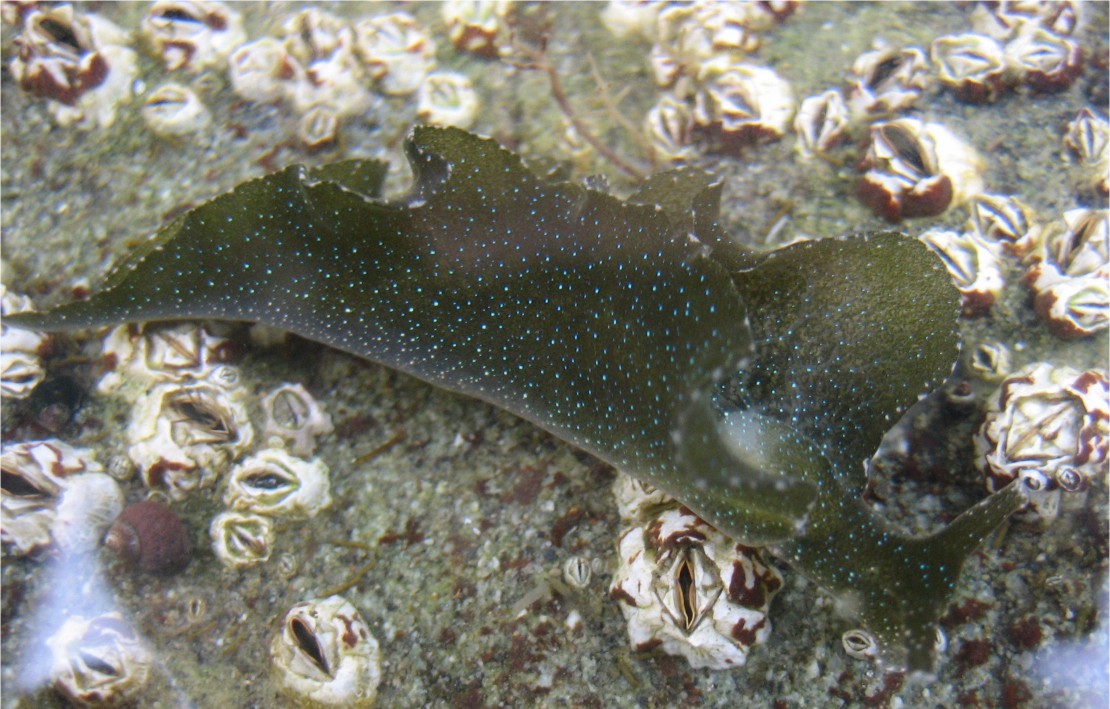Elysia hedgpethi Marcus, 1961Common name(s): Hedgpeth's sea hare |
|
| Synonyms: Elysia bedeckta |  |
| Phylum Mollusca
Class Gastropoda Subclass Opisthobranchia Order Sacoglossa Family Elysiidae |
|
| Elysia hedgpethi, about 5 cm long, in a high tidepool at Beach #4 near Kalaloch, WA | |
| (Photo by: Brooke Reiswig, July 2006) | |
How to Distinguish from Similar Species: Other sacoglossans have no parapodia but do have cerata.
Geographical Range: Vancouver Island, Canada to Bahia Tortugas, Baja California, Mexico; Bahia de Los Angeles
Depth Range: Low intertidal and subtidal (sometimes on mud flats)
Habitat: Lives near its food; Codium fragile and Bryopsis corticulans.
Biology/Natural History: Herbivorous. Feeds on the green algae Codium fragile and Bryopsis corticulans. Branches of the digestive gland pass through the lateral "parapodia" flaps. The chloroplasts from the alga enter into these glands and continue to photosynthesize for up to 10 days after the animal has eaten them. "Sacoglossan" means "sack tongue", and refers to a sack at the base of the radula. The radula of this group has an enlarged, sharp tooth that slits open algal cells so the animal can suck out the contents. The sack at the base of the radula holds teeth which have been discarded. Egg strings are white cylinders, laid in a counterclockwise spiral 4-6 mm diameter. Often laid on Codium fragile. The chloroplasts of a congener of this species, Elysia clarki (which lives near mangroves in Florida) were recently found to have come from several different species of algae (Curtis et al., 2006).
Some sacoglossans vary the life history characteristics of their larvae, and larvae within the same clutch may have different characteristics. This is thought to be adaptive for utilizing the patchy habitat of specialized herbivores such as sacoglossans (Krug, 2009)
Some close relatives of this species, including E. chlorotica from North Atlantic shores, are able to maintain functional chloroplasts in their tissues for months after their last feeding on algae. The chloroplasts have not bee observed to divide, but do continue to function. This long-term maintenance would seem to require synthesis of new chlorophyll since chlorophyll naturally breaks down. In algae, some of the chlorophyll-synthesizing genes are in the chloroplast and others are in the nuclear DNA. So without these nuclear chlorophyll-synthesizing genes it would not seem possible to synthesize new chlorophyll. The initial steps of the metabolic pathway for synthesizing chlorophyll are the same as those for synthesizing hemoglobin and cytochromes, which do occur in animals, but the later steps only occur in plants and algae with chloroplasts. Several recent papers (Pierce et al., 2007; Pierce et al., 2009) have shown that the animal cells themselves of E. chlorotica contain several key chlorophyll-synthesizing enzymes within them, and have presented strong evidence that new chlorophyll is actually synthesized in the animals. The chlorophyll-synthesizing genes have DNA sequences characteristic of algae, not of animals. This appears to be a very unusual case of actual transfer of a functional set of genes from a food/symbiont to the nuclear DNA of a multicellular host.
| Return to: | |||
| Main Page | Alphabetic Index | Systematic Index | Glossary |
References:
Dichotomous Keys:Kozloff 1987, 1996
Smith and Carlton, 1975
General References:
Behrens,
1991
Kozloff,
1993
Morris
et al., 1980
Scientific Articles:
Curtis,
Nicholas E., Steven E. Massey, and Sidney K. Pierce, 2006.
The
symbiotic chloroplasts in the sacoglossan Elysia clarki
are from
several algal species. Invertebrate Biology 125:4 336-345
Krug, Patrick J., 2009. Not my "type": larval dispersal dimorphisms and bet-hedging in opisthobranch life histories. Biological Bulletin 216: 355-372 (Concerns Elysia but does not mention E. hedgpethi)
Pierce, S. K., N. E. Curtis, J. J. Hanten, S. L. Boerner, and J. A. Schwartz, 2007. Transfer, integration and expression of functional nuclear genes between multicellular species. Symbiosis 43: pp 57-64
Pierce, Sidney K., Nicholas E. Curtis, and Julie A. Schwartz, 2009. Chlorophyll a synthesis by an animal using transferred algal nuclear genes. Symbiosis 49: pp. 121-131
Web sites:
General Notes and Observations: Locations, abundances, unusual behaviors:
Authors and Editors of Page:
Dave Cowles (2006): Created original page